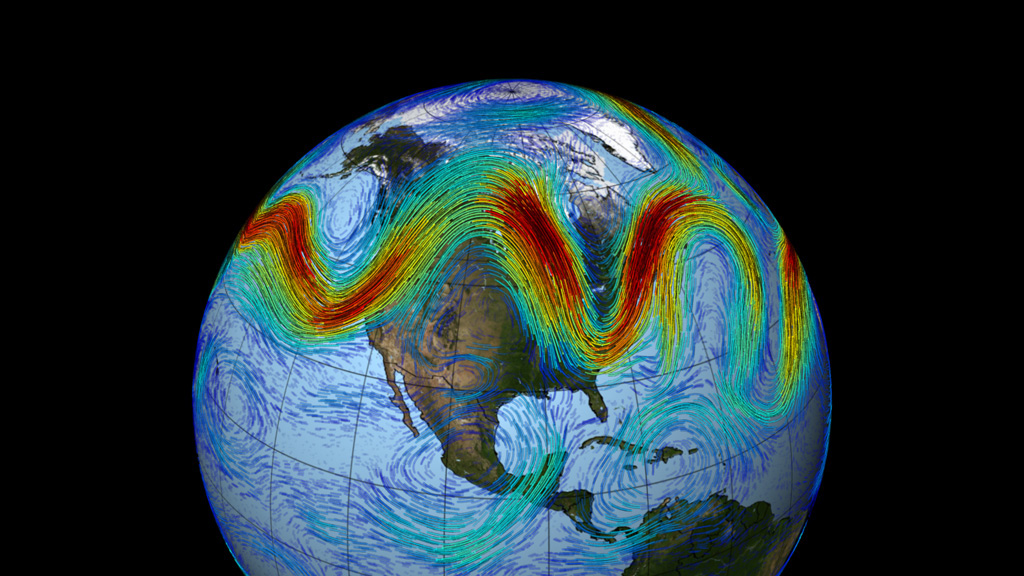Study: Global warming is affecting the jet stream so that extreme weather is more likely to persist for longer periods

Ever since 2012, scientists have been debating a complex and frankly explosive idea about how a warming planet will alter our weather – one that, if it’s correct, would have profound implications across the Northern Hemisphere and especially in its middle latitudes, where hundreds of millions of people live.
The idea is that climate change doesn’t merely increase the overall likelihood of heat waves, say, or the volume of rainfall – it also changes the flow of weather itself. By altering massive planet-scale air patterns like the jet stream, which flows in waves from west to east in the Northern Hemisphere, a warming planet causes our weather to become more stuck in place. This means that a given weather pattern, whatever it may be, may persist for longer, thus driving extreme droughts, heat waves, downpours and more.
This basic idea has sparked half a decade of criticism and debate, and at the cutting edge of research, scientists continue to grapple with it. And now, a new study once again reinforces one of its core aspects.
Publishing in Nature Scientific Reports, Michael Mann of Pennsylvania State University and a group of colleagues at research institutes in the United States, Germany and the Netherlands find that at least in the spring and summer, the large scale flow of the atmosphere is indeed changing in such a way as to cause weather to get stuck more often.
The study, its authors write, “adds to the weight of evidence for a human influence on the occurrence of devastating events such as the 2003 European heat wave, the 2010 Pakistan flood and Russian heat wave, the 2011 Texas heat wave and recent floods in Europe.”
But what does it mean for global warming to alter the jet stream? The basic ideas at play here get complicated fast. The study itself, for instance, refers to “quasi-resonant amplification (QRA) of synoptic-scale waves” as the key mechanism for how researchers believe this is happening – terminology sure to impart terror in nonscientists worldwide.
On the other hand, some of this isn’t all that complicated. The Northern Hemisphere jet stream flows in a wavy pattern from west to east, driven by the rotation of the Earth and the difference in temperature between the equator and the North Pole. The flow is stronger when that temperature difference is large.
But when the Arctic warms up faster than the equator does – which is part of the fundamental definition of global warming, and which is already happening – the jet stream’s flow can become weakened and elongated. That’s when you can get the resultant weather extremes.
“It’s sort of like if you confine an electromagnetic wave to a coaxial cable, then you’re not losing energy, it’s being tightly contained in that cable and sent to your television,” said Mann. “These waves aren’t losing energy, so they grow and get larger and get stuck in place as well.”
What the new study is saying is that in summer, in particular, this can occur. Moreover, it finds that a particular temperature pattern is linked to that behavior – and this temperature pattern, featuring an extra warm Arctic, is becoming more frequent over time, based on both observations and also a review of the outputs of high powered climate change models that the researchers conducted.
“We think that the signal has emerged from the noise over the last decade,” said Mann.
One researcher who co-wrote an influential 2012 study suggesting that changes in the Arctic could be driving mid-latitude weather extremes, Stephen Vavrus of the University of Wisconsin, praised the new research in an emailed comment Monday. “This study goes beyond statistical correlations and explores a specific process that can plausibly explain how enhanced high-latitude warming trends may trigger remote weather impacts,” he said.
But other scientific authors have expressed considerable skepticism of these kinds of ideas in the past. A recent study in Nature Geoscience, for instance, called into question whether the Arctic’s melting, and in particular its sea ice loss, has been causing winter cooling over Eurasia, another idea that has been swept up in the debate over the jet stream and weather extremes.
One author of that study, John Fyfe of the Canadian Center for Climate Modeling and Analysis at Environment and Climate Change Canada, remarked of the Mann paper by email: “It is well established that there has been a human influence on the large-scale atmospheric circulation and temperature of the Northern Hemisphere. Mann et al. advance a theory that attempts to link those changes to changes in the spectrum of shorter-scale waves in the atmosphere, which are our weathermakers. I do not believe that this theory is fully developed or that the implications have been fully explored, but I do think that Mann et al. study is a very good start.”
The current study really only covers weather extremes in the spring and summer. For extremes occurring in winter, Mann said, we need to look to other mechanisms for odd atmospheric behavior. Nonetheless, the work represents yet another suggestion that a changing climate is leading to a changing pattern of atmospheric flow, with major implications for the weather felt by a massive swath of the global population.
Mann, who testifies before Congress this week in a session that is expected to feature a rip-roaring debate about the severity of climate change, commented, “That’s going to be a fake debate. But this stuff is where the real debate is now.”